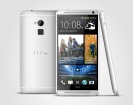Introduction
It's phablet o'clock on HTC's watch and they're shifting gear and changing direction. Done expanding the One portfolio towards the compact end of the spectrum, HTC are going the other way with the aptly named One Max. It builds on a proven formula emphasizing media consumption and looks, while bringing a few welcome new features to the lineup.
HTC One Max official images
The expandable storage deals with one of the chronic liabilities of the One, so you're no longer limited in your selection of videos and songs to enjoy on the excellent speakers and the now even bigger screen. There's also the latest Android release powering the whole thing, coupled with the most up-to-date edition of HTC's proprietary Sense UI.
Key features
- Quad-band GSM/GPRS/EDGE support; 3G with HSPA; LTE
- 5.9" 16M-color 1080p Super LCD3 capacitive touchscreen with 373ppi pixel density
- Android OS v4.3 Jelly Bean with Sense UI 5.5
- Quad-core 1.7 GHz Krait 300 CPU, 2 GB RAM, Adreno 320 GPU; Qualcomm Snapdragon 600 chipset
- 4 MP autofocus "UltraPixel" camera with 1/3" sensor size, 2µm pixel size; LED flash
- 1080p video recording @ 30fps with HDR mode, continuous autofocus and stereo sound
- HTC Zoe
- 2.1 MP front-facing camera, 1080p video recording
- Wi-Fi a/b/g/n, Wi-Fi Direct and DLNA; Wireless TV-out (Miracast)
- GPS with A-GPS, GLONASS
- 16GB/32GB of built-in storage, expandable via a microSD slot
- MHL-enabled microUSB port
- Bluetooth v4.0
- NFC
- Standard 3.5 mm audio jack
- Accelerometer and proximity sensor
- Active noise cancellation with dedicated mic
- Sleek aluminum body
- Front-mounted stereo speakers with BoomSound tech
- Class-leading audio output
Main disadvantages
- 4MP UltraPixel camera has less than stellar performance in good light
- Non user-replaceable battery
- Poor video and audio codec support out of box
- Fingerprint scanner let down by software support
- Snapdragon 600 chipset is no longer the snappiest around
The choice of Snapdragon 600 over its more capable Snapdragon 800 sibling is bound to raise a few eyebrows, but realistically, the Snapdragon 600 is no slouch either and it has never left an impression of being underpowered. And with the resolution unchanged over the HTC One, there will be no extra strain on the GPU to worry about either.
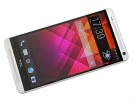

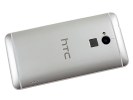
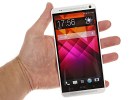
The HTC One Max at ours
So what we need to find out now is whether the Sense UI 5.5 is as good as HTC touts it to be, and whether the fingerprint scanner can be a key selling point. We already saw an excellent hardware implementation of the feature by Apple in the iPhone 5s, but the software failed to make proper use of it. We now set out to find what HTC did differently and how well it works.
But first thing - first. The HTC One Max is getting a proper physical examination right after the break.
HTC One Max 360-degree spin
The HTC One Max measures 164.5 x 82.5 x 10.3 mm, which makes it notably larger than the Samsung Galax Note 3 (151.2 x 79.2 x 8.3 mm). The extra millimeters around the waistline are particularly easy to feel on a device of this size and along with the much heavier weight (217g vs 168g) make the One Max notably harder to wield than the Galaxy phablet.
Of course, the HTC One Max has dual front-mounted speakers and a 0.2" larger screen to show for it, and it's up to everyone to decide for themselves whether the trade-off is worth it.

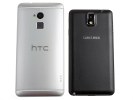
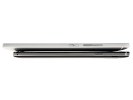

HTC One Max sized up against the Samsung Galaxy Note 3
Design and handling
The HTC One Max is an instantly recognizable member of the company's high-end lineup. It offers the same combination of metal, high-quality plastic and glass as the One mini and provides the same premium feel as the other two members of the One family.
The entirely plastic sides are certainly not as cool at the metal edges on the original One, but they are certainly more durable and since they don't take too much away in terms of looks, we find this a good solution.
Of course a device this big can't quite match the sophistication of the mini (or even the original One), but once you hold the One Max you will immediately know that it's a premium offering. And while the weight might take its toll on the usability it certainly contributes to the solid vibe the phablet gives.

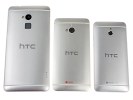
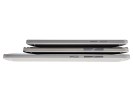
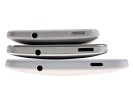
The HTC One family portrait
And, yes, the fingerprint sensor doesn't sit as pretty on the silver back as it did on the home button of the iPhone 5s, but that's mostly nitpicking. Bottom line is the HTC One Max is a sleek smartphone, which you'd feel proud of owning (once you get past the usual "is that a phone or a tablet" jokes).
Controls
The fingerprint scanner aside, the HTC One Max features the same set of controls as the other two members of the One family.
The front panel still features a loudspeaker with BoomSound tech either side of the screen. A strip of glass right below the display is home to the two capacitive keys, Back and... well, Home. A long-press the Home button launches Google Now, while a double tap brings up the task switcher.
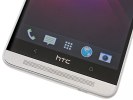
The two capacitive keys
There are no dedicated Menu and App switcher keys, but their absence is made up for with clever gestures around the UI. Normally you need to pull down when at the top of a list (app drawer or BlinkFeed for example) to reveal the extra available settings.
Above the screen is the front-facing camera, plus the ambient light and proximity sensors. The top speaker takes the role of an earpiece during calls.

The front-facing camera and the usual sensors on top
The front-facing camera on the HTC One Max is the same as on the One - it has a 2.1MP sensor with a wide-angle lens and it can shoot even 1080p video, complete with HDR mode.
The right side of the phablet features a couple of keys - the volume rocker and the power button. We have complained about HTC placing the power keys on its smartphone on top, where reaching it is the hardest and the company has finally listened. Not only is the right side of the One Max the most obvious choice for the location of a button as frequently used as this one, but the location also lets you index finger fall right above the fingerprint scanner when unlocking the device.
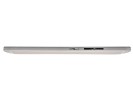
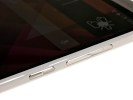
In a welcome break of tradition, the power key has joined the volume rocker on the right
The microUSB port and the mouthpiece are at the bottom. The USB port is MHL-enabled, so you can use it for HD TV-Out and for USB Host functionality. There's a noise cancelling mic at the back of the phablet. Besides its usual noise cancelling duties, the second mic keeps track of how loud the ambient noise is and the One Max will boost the sound from the mouthpiece to make sure the other side hears you loud and clear.
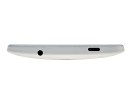
The mouthpiece and the microUSB port
The top of the HTC One Max features the 3.5mm audio jack and the IR emitter, which can be used for controlling various home equipment. The phablet comes with a remote app preinstalled and we found it to work quite well, while supporting a long list of devices.


The audio jack and the IR blaster
Controls (continued)
The left side of the HTC One Max houses the knob that releases the back panel. The detachable back plate is the other big difference when comparing the phablet to the international version of its One sibling.
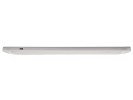
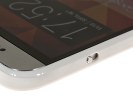
The back panel release
The back of the HTC One Max is way busier than those of the One and One min. You get the familiar cutouts for the 4 megapixel camera lens and its LED flash, but there's more going on this time around.
Right under the camera lens sits the fingerprint scanner. HTC has stayed mum on what makes it tick, but it confirmed that the sensor here operates differently to the Apple's Touch ID. Not that we couldn't have figured that out by ourselves as the One Max requires you to swipe you finger over it, rather than just place it on top.
The good news is that we found the One Max fingerprint scanner to be quite quick to react and accurate enough to be actually usable. We'll pay the feature and its functionality a bit more attention later on.
The other elements of interest at the back are the secondary microphone used for noise cancelling and the pogo pins that are used for attaching the battery-extending Power Flip Case.


A look at the HTC One Max back
Battery life
Despite featuring a removable back panel, the HTC One Max doesn't grant you access to its 3,300mAh Li-Po battery. All you get underneath are the microSIM and microSD slots. Memory expansion is a feature many have looked for in the One lineup for a while now and it's good to see HTC finally delivering.
We completed the batter test and the ample battery delivered quite impressive numbers. The final score was an exciting 81h, and the endurance in the individual challenges was great too.

HTC One Max battery test scorecard
You can find the complete breakdown of the One Max battery performance over here.
Gorgeous 5.9" display
The HTC One Max has a brilliant 5.9" IPS LCD screen, that has an image quality quite similar to the HTC One 4.7-incher. The extended diagonal has caused the pixel density to drop to just 373ppi, but at this point the difference is rather hard to spot.

The 5.9" 1080p screen looks great
HTC has been putting out some excellent screens recently and the One Max's display is just another example of this. The contrast is impressive and the viewing angles are extremely wide - there's no shift in colors and only a slight contrast loss at extreme angles.
| Display test | 50% brightness | 100% brightness | ||||
| Black, cd/m2 | White, cd/m2 | Black, cd/m2 | White, cd/m2 | |||
| HTC One Max | 0.14 | 224 | 1591 | 0.40 | 629 | 1572 |
| Samsung Galaxy Note 3 | 0 | 149 | ∞ | 0 | 379 | ∞ |
| Sony Xperia Z1 | - | - | - | 0.38 | 580 | 1513 |
| Sony Xperia Z Ultra | - | - | - | 0.47 | 467 | 1001 |
| Sony Xperia Z | - | - | - | 0.70 | 492 | 705 |
| Huawei Ascend Mate | 0.23 | 222 | 982 | 0.67 | 711 | 1053 |
| Samsung Galaxy Mega 6.3 | 0.12 | 160 | 1364 | 0.32 | 440 | 1379 |
| Samsung I9505 Galaxy S4 | 0 | 201 | ∞ | 0 | 404 | ∞ |
| HTC Butterfly S | 0.15 | 165 | 1117 | 0.43 | 451 | 1044 |
| HTC One | 0.13 | 205 | 1580 | 0.42 | 647 | 1541 |
The screen is laminated too, for a maximum close fit between individual layers, bringing the image as close as possible to the surface of the glass.
The only area of the HTC One Max screen performance that could be improved is sunlight legibility. It's not doing bad by any means, helped by its good brightness levels, but it's not quite up there with the best either.


